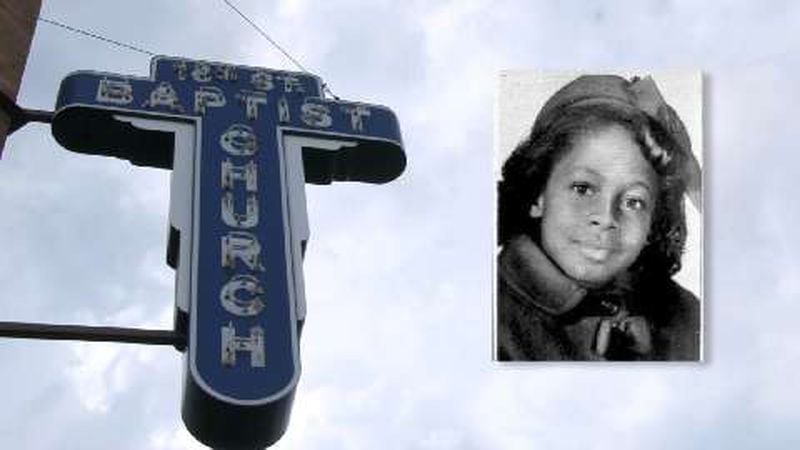This article was originally published in 2013
Kimberly McNair Brock’s “in-your-face moment” came when she was 8 or 9 years old. Friends and family were gathered for Sunday dinner at her grandparents’ house when someone mentioned Denise, the older sister she never knew.
An uncomfortable silence followed. Adults exchanged glances. There had been many such unexplained moments during her childhood. The moments when Denise’s name was uttered in hushed whispers.
Suddenly, her grandmother, Clara “Dear Dear” Pippen, ushered Kim, her big sister, Lisa, and others into her living room. In that instant, the family matriarch decided it was time that Kim and Lisa, then 12 or 13, learned the truth about the way their sister died. She wanted them to know what happened, to understand, so when they heard the whispers about Denise they would know.
She pulled out a cardboard box. Looking inside, Kim saw a pair of black patent leather shoes, a matching purse, a few coins, a tiny bottle of eye drops and some crumpled tissues. They belonged to her sister.
One item stood out: a flat piece of concrete the size of a fist.
That, said her grandmother, was embedded in Denise’s head.
2 Carol Denise McNair
Thelma “Maxine” Pippen met Christopher McNair during her freshman year at Tuskegee Institute in 1945. She hailed from nearby Birmingham and he was from the tiny town of Fordyce, Ark. They were playing around with friends in the cafeteria one day when they caught each other’s eyes. At first, she just thought of him as a good friend. Everyone called him “Wahoo.”
After Chris McNair’s stint in the Army, he and Maxine graduated from Tuskegee in 1949. He landed a job in Tupelo, Miss., teaching veterans. On the weekends, he visited Maxine in Birmingham and stayed with her grandparents. They went to movies and “couch courted.”
A year later, they married and settled in Tupelo. When she became pregnant, they moved to Birmingham so Maxine McNair could be near her mother. The couple’s first child, Carol Denise, was born on Nov. 17, 1951. Like most first-born children, Denise was the center of her parents’ lives. Her grandparents and friends in the McNair’s suburban neighborhood, between Midfield and Bessemer, doted on her, too.
Chris McNair took lots of photographs: Denise as a baby. Denise as a toddler, smiling from ear to ear. Denise in a red winter coat with a matching hat. Denise clutching a Chatty Cathy doll close to her face. She loved that doll.
Denise was a “busy little bee,” recalled her mother. “She wanted to know what everything was all about. She was very outgoing. She liked to cook and sew things, and she was a leader among her friends.”
One of Denise’s early playmates was Condoleezza Rice, a gifted pianist who would one day rise to President George W. Bush’s cabinet. Rice was born and raised in Birmingham, where her father was a pastor.
Denise attended Center Street Elementary School; her mother taught there.
Mother and daughter shopped at the major department stores downtown. “As long as you had money you could shop there,” she said. But African-Americans could not get a sandwich at a lunch counter.
It was left to Chris McNair to explain to his beloved daughter why.
Like most Southern cities in the 1950s and ’60s, white people had their place and black people had theirs in segregated Birmingham. Unable to find work as a teacher or in the steel mills, Chris McNair made his living as a neighborhood milkman. He was gregarious and always on the go. He was handy with a camera, too, and took portraits, photographed reunions, weddings and other special events.
When the Rev. Martin Luther King Jr. emerged from jail after writing his famous “Letter from Birmingham jail,” in April 1963, Chris McNair captured an image of King and the Rev. Ralph David Abernathy, who’d come over from Atlanta.
King preached his message of nonviolence in one of the most violent cities in America where, in the years after World War II, dozens of homes and churches were bombed. The city became known as “Bombingham.”
For years, Birmingham’s public safety commissioner, Eugene “Bull” Connor, contributed to a culture of fear and loathing toward black citizens, many of whom worked in the city’s steel mills or in white homes as domestic workers. Connor had ordered the city’s firemen to use high pressure water hoses to disperse protesters, many of them children. Police dogs attacked demonstrators in Kelly Ingram Park. Hundreds were arrested almost daily.
The same year of the bombing, Gov. George Wallace stood in the doorway of the University of Alabama to block two black students from enrolling. When he refused to step aside, President John F. Kennedy sent federal troops.
On Sept 10, 1963, Kennedy signed an executive order to desegregate the city’s schools, nine years after the U.S. Supreme Court issued its Brown v. Board of Education decision declaring separate and unequal schools unconstitutional. Whites in Birmingham were furious at the prospect of sending their children to school with black children.
The Rev. Fred Shuttlesworth and the Rev. John Cross, pastor of the 16th Street Baptist Church, were among those leading local efforts on behalf of African-Americans. They often held strategy meetings at the church, a fact that became known to those who wanted to stop the movement, at any cost.
3 Murder at a church
Maxine McNair got her daughter up early the morning of Sept. 15, 1963. Denise, 11, wore her Sunday dress and black patent leather shoes. It was youth Sunday and they wanted to be on time. Chris McNair went to his own church, St. Paul Lutheran, a few miles away.
It was overcast when 12-year-old Sarah Collins Rudolph and her sister, Addie Mae Collins, walked to 16th Street for Sunday school. As Sunday school was winding down, they joined three other girls in the ladies’ dressing room in the church’s basement, excitedly preparing for the youth services to follow. They planned to sing in the choir or serve as ushers. Denise asked Addie Mae to tie the sash on the back of her dress.
That was the last thing Sarah Collins Rudolph, now 62, remembers before a powerful explosion shook the building, hurling glass and concrete in every direction.
Maxine McNair was upstairs in the choir stand with her Sunday school class at the time.
“I heard a loud noise. The bricks were falling down. I said, ‘Let me go find my child! My baby, my baby!’”
She dashed out of the front door and ran into someone who told her a woman had carried some children to her house. When Maxine McNair turned to go there, someone else told her no, Denise was taken to the hospital. She was hurt.
Within minutes, Chris McNair heard about the explosion and headed toward 16th Street. A cousin stopped him and directed him to go to the hospital, where he found his wife.
“We looked and looked,” Maxine McNair said. When they found Denise, “there was this big old rock sticking in her head and she was dead. I just broke down and they carried me to my Mother and Daddy’s house. I just couldn’t stop crying, and Mother and Daddy tried to console me. Chris, too.”
The bodies of Carole Robertson, Addie Mae Collins and Cynthia Wesley, all 14, were also pulled from the dusty site of the bombing. From her hospital bed, Sarah Collins — eyes bandaged — overheard someone say her sister Addie was dead.
Before the day’s end, two more black children would be murdered.
Sixteen-year-old Johnnie Robinson was reportedly throwing rocks when he was shot in the back by a city police officer. Virgil Ware, 13, was riding on the handlebars of his older brother’s bike when he was shot and killed by a white teenager. Later, the teen was sentenced to six months in a juvenile detention center. The police officer was never prosecuted.
The church bombing made headlines around the world. What kind of people blow up a church and kill four little girls? It would take decades before Ku Klux Klan members who planted the bomb were brought to justice: Robert “Dynamite Bob” Chambliss in 1977; Thomas E. Blanton in 2001 and Robert Cherry in 2002. A fourth man, Herman Frank Cash, died before he could be tried.
Maxine and Chris McNair began making plans to bury their child when civil rights leaders suggested a joint funeral, with King giving the eulogy. The Robertson family made separate arrangements.
Maxine McNair doesn’t remember what King said that day.
"It was just one of those things, you just have to scream and holler until you get it out. Then the next thing you're asleep, then you are waking up." She still couldn't imagine it was real. "What am I doing here?" she asked, over and over. "You are not supposed to die at church ... in such a vicious manner."
She was angry, confused, bewildered and stunned. Denise’s death had a different effect on Chris. He didn’t allow himself to cry.
4 A time for healing
Lisa McNair was born a year and four days after Denise’s death. Four years later, Kim was born. Maxine McNair busied herself with raising her daughters and teaching. The McNairs made a conscious decision to prevent Denise’s death from overshadowing the lives of their daughters.
Birmingham’s black and white residents were fearful and angry after the murders. Would other churches whose pastors were involved in the movement be targeted? When would the killers be found and punished? Would whites who helped blacks be targeted? When the initial shock subsided, blacks and whites began to talk.
Chris McNair was a part of those discussions. Eventually he decided to run for public office and in 1974 became one of the first black state legislators since Reconstruction. In 1986, he began serving on the Jefferson County Commission.
“Instead of becoming bitter and hateful and resentful and moving away and throwing up his hands, he decided to try to make this city a better place,” said Doug Jones, the attorney who prosecuted two of the bombers and later represented Chris McNair. “And he did.”
Lisa and Kim grew up in an alternate universe from their sister Denise, who would have turned 62 this year.
They attended elite private schools and made friends with people of all races. They rarely told friends about their family’s unique place in history.
Now 48, Lisa McNair remembers her mother mentioning Denise on her birthday or on the anniversary of her death. As they got older, Lisa and Kim asked questions about Denise. What was she like? What did she like to do?
Lisa once found an old 45 rpm record of Denise’s voice that her parents had. The record was broken into pieces and Lisa never got to listen to it. “I longed to hear her voice because people always said Mama, Kim and I all sounded alike.” Yet the full gravity of her sister’s murder didn’t hit her until 2002, when she attended Cherry’s murder trial and an expert witness described the effect of a bomb on a body.
“I almost lost it.”
The McNairs have never expected to be compensated for Denise’s death. No amount of money would bring her back. Their desire is for reconciliation and healing. Lisa McNair, who earned a psychology degree from the University of Alabama, works for a local nonprofit and has immersed herself in projects that honor her sister’s memory.
One such effort is Sojourn to the Past, a California-based organization that sends high school students on trips to the deep South, where they learn about the country’s racial past. At a screening last month of “Four Little Girls,” a Spike Lee documentary about the bombing, at Canterbury United Methodist Church, about 100 people of all races gathered to watch the film, hear from Lisa McNair and pray for understanding.
The church is in Mountain Brook, a wealthy Birmingham suburb. When an elderly white woman seated on the front row stood up to ask Lisa McNair a question, a woman near the back of the auditorium said to a friend, “Oh goodness, I hope she doesn’t embarrass us.” She didn’t.
Lisa McNair sees these events as a way to heal. In the months after the murders, she told the crowd, white women reached out to her mother and other black women, inviting them to tea.
“Their mothers were fearful for them,” Lisa McNair said of the city’s white children. “This was a pivotal moment in the struggle for justice ... People were fighting, then one day people killed four girls in a church.”
Lisa McNair’s sister, Kim Brock, earned a fine arts degree from Auburn University and went on to graduate from the Culinary Arts program at Johnson and Wales University in Denver, Colo. She met her husband, Jimmie Brock, in church. He didn’t learn about his wife’s connection to Denise until after they were married.
Around Birmingham, Kim Brock, 44, is known as Chef Brock. She is guarded about who she lets into her circle — ever skeptical of people’s motives — and fiercely protective of her mother. Neither woman is angry about what happened to their sister, though that hasn’t always been the case. Lisa McNair recalls asking her mother if they were supposed to hate white people. No, Maxine McNair told her, Jesus wants us to love everybody.
Lisa McNair and the Brocks all live with Maxine McNair in the family home, which has been expanded twice. Pictures line the walls and stand on tables. One of Denise is contained in a wooden, butterfly-shaped frame, surrounded by pictures of her sisters, their father and their grandmother. Maxine McNair teases her married daughter about giving her a grandchild. For now, Banjo, the family dog, will have to suffice as “grand dog.” Jimmie Brock jokes with his mother-in-law and teaches her silly songs.
Maxine McNair suffers from Alzheimer’s disease, glaucoma and other health problems. Kim Brock and her husband moved in two years ago to help take care of her around the time Chris McNair, then 85, began serving a five-year prison sentence. He accepted $140,000 in bribes from contractors working on a $3.2 billion county sewer project while serving on the Jefferson County Commission. He was ordered to pay more than $400,000 in restitution and began serving his sentence in 2011, after his appeals were exhausted.
Every day Maxine McNair talked to her husband on the phone for 15 minutes. Married 63 years, the couple chatted about their day.
In May, Maxine and Lisa McNair traveled to the White House to witness President Obama sign legislation designating Congressional gold medals for Denise and the three other girls. Maxine McNair asked the president to have mercy on her husband. Two years earlier, Obama had denied a request for clemency.
But last month, Chris McNair became one of the first prisoners released under new guidelines from the Obama administration that allow for the early release of sick, elderly federal inmates. The midnight homecoming on Aug. 28 was an emotional one for Chris McNair, 87, and his family.
Some in Birmingham cried foul and wondered if he was given special treatment, given the timing of his release just before the 50th anniversary of the bombing.
Last Tuesday, the Congressional Gold Medal was awarded posthumously to the families of the girls.
Maxine McNair, 85, often grows confused these days. She remembers some details perfectly and struggles to recall others.
Referring to Denise, she recently sat in her home, surrounded by pictures of her family, and said, “I can’t remember what high school she went to.”
“She didn’t go to high school,” her daughter Kim Brock reminded her. “She died when she was 11.”
She died when she was 11, Maxine McNair repeated softly.
HOW WE GOT THE STORY Fifty years ago today, members of the Ku Klux Klan bombed a church in Birmingham, Ala., killing four young African-American girls. AJC editor Angela Tuck had always wondered how the families of the girls moved on after such as horrific crime. She contacted Malena Cunningham, a friend and former journalist in Birmingham, who put her in contact the McNairs. Last month Tuck, photographer Johnny Crawford and videographer Ryon Horne traveled to Birmingham to spend time with the McNair family, whose 11-year-old daughter, Denise, was one of the victims. Maxine McNair, the only surviving mother of a bombing victim, along with her daughters, Lisa McNair and Kim Brock, generously shared their memories about Denise and the years of sorrow and healing that followed. On a subsequent trip, Tuck saw Lisa McNair speak at Canterbury United Methodist Church and interviewed friends and associates of the family. In researching the story, she read parts of Diane McWhorter’s Pulitzer Prize-winning book, “Carry Me Home,” and re-watched Spike Lee’s documentary, “Four Little Girls.” Tuck tells a moving, sensitive story about a national tragedy, its personal toll and the power of forgiveness.
-Suzanne Van Atten Features Enterprise Editor
About the reporter
Angela Tuck, has is a longtime a reporter and editor at the AJC. A native of Lexington, Ky., she has also worked as a reporter for the Lexington (Ky.) Herald-Leader and the St. Petersburg Times and as a deputy metro editor at the Detroit Free Press. In 2011, she did a series of articles on 10 of the 1961 Freedom Riders who live in Atlanta, including Congressman John Lewis.
About the photographer
Johnny Crawford joined the AJC 27 years ago as an intern after graduating from Morehouse College. He is the beat photographer for Georgia Tech football and has also covered NASCAR and the Olympics in Atlanta, Norway and China. He also teaches photography classes at the Smyrna Community Center.
About the Author






